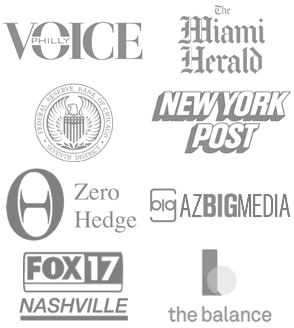Owning a home is a dream for many, but saving for a down payment can be one of the biggest hurdles. Fortunately, purchasing a home with no money down is possible through various financing options, government programs, and creative strategies. Many real estate investors anticipate 2025 to be a great opportunity to buy a house with zero-down home loans because interest rates are forecasted to fall and banks should be more aggressive with home loan programs for first time buyers.
How to Buy a House with No Money Down
The RefiGuide has been connecting home buyers with banks and mortgage lenders that offer no money down home loans in the United States.
We published this home buying guide to explore the best methods to buy a house without a down payment, zero money down, eligibility requirements, and potential pros and cons.
1. VA Loans – Best for Veterans and Active Military
The U.S. Department of Veterans Affairs (VA) offers one of the best zero down payment mortgage programs for eligible service members, veterans, and surviving spouses. VA house loans come with several benefits, including:
Key Features of VA Loans:
- 0% down payment required
- No private mortgage insurance (PMI)
- Competitive interest rates
- Lenient credit score requirements
To qualify for a VA loan, you must meet the service eligibility criteria and obtain a Certificate of Eligibility (COE) from the VA. Additionally, the home must be your primary residence, and lenders will still assess your credit score and debt-to-income (DTI) ratio.
2. USDA Loans – Best for Rural and Suburban Buyers
The U.S. Department of Agriculture (USDA) provides 100% financing for eligible rural and suburban homebuyers through the USDA Rural Loan Program.
Key Features of USDA Loans:
- 0% down payment required
- Low mortgage insurance costs
- Competitive interest rates
- Income limits apply
To qualify for a USDA loan, the home must be located in an eligible rural or suburban area, and you must meet income eligibility guidelines. Borrowers with a credit score of 640 or higher typically receive streamlined approval.
3. Down Payment Assistance (DPA) Programs
Many state and local governments offer down payment assistance (DPA) programs to help buyers secure a home with little to no money down.
Types of DPA Programs:
- Grants – Free money that does not need to be repaid.
- Forgivable Loans – Loans that are forgiven after a set period if you stay in the home.
- Deferred Payment Loans – No payments required until you sell or refinance the home.
- Matched Savings Programs – Some states offer savings programs where your savings are matched by the government or nonprofits.
To qualify, for these types of purchase money mortgage loans you may need to meet income limits, complete a homebuyer education course, and purchase a home in a designated area.
4. FHA Loans with Down Payment Assistance
The Federal Housing Administration (FHA) does not offer zero-down loans, but it allows buyers to use gift funds or down payment assistance programs to cover the 3.5% down payment requirement.
How to Use FHA Loans with DPA:
- Check for state or local DPA programs.
- Use gifted funds from family.
- Explore FHA-approved grants.
FHA loans are easier to qualify for, with credit score requirements as low as 580 for a 3.5% down payment, making them a great option when paired with DPA programs.
5. Rent-to-Own Loan Programs
The rent-to-own home programs allow you to rent a home with the option to buy it later. A portion of your rent payments may be applied toward the purchase price.
How Rent-to-Own Works:
- You sign a lease agreement with the option to buy the home.
- You make monthly rent payments, with a portion allocated to the home purchase.
- You may need to pay an option fee upfront (1-5% of the home’s price).
- When the lease ends, you secure a mortgage to buy the home.
This option is great for buyers who need time to improve credit or save for closing costs.
6. Negotiating Seller Concessions
A motivated home seller may agree to cover part or all of your closing costs, reducing the cash needed at closing.
Ways to Negotiate Seller Concessions:
- Request the seller to cover closing costs (typically 3-6% of the home price).
- Ask for down payment assistance.
- Negotiate price adjustments in lieu of out-of-pocket expenses.
Seller concessions are more common in buyer’s markets, where sellers are motivated to close the deal.
7. Employer and Community Homebuyer Programs
Some employers and organizations offer homebuyer assistance programs for their employees, including:
- Employer-Assisted Housing (EAH) programs
- First Responder & Teacher Assistance Programs
- Union-sponsored mortgage assistance
These programs often provide grants, low-interest loans, or homebuyer incentives to help employees afford a home.
8. VA Native American Direct Loan (NADL)
For eligible Native American veterans, the VA offers the Native American Direct Loan (NADL) program, which allows borrowers to buy, build, or improve homes on federal trust land with no down payment.
Key Features:
- 0% down payment required
- Low-interest rates
- No private mortgage insurance (PMI)
To qualify, you must be a Native American veteran and the home must be located on tribal trust land.
Pros and Cons of Buying a Home with No Money Down
Pros:
✅ No need to save for years – Faster homeownership.
✅ More cash available for moving costs, repairs, and emergencies.
✅ Down payment assistance programs reduce upfront costs.
Cons:
❌ Higher monthly mortgage payments due to larger loan amounts.
❌ Potentially higher interest rates compared to conventional loans.
❌ Strict eligibility requirements for USDA, VA, and DPA programs.
❌ Private mortgage insurance (PMI) may be required, increasing costs.
Steps to Buy a Home with No Money Down
Step 1: Check Eligibility for Zero-Down Programs
- Are you a veteran, active-duty service member, or surviving spouse? → VA Loan
- Do you want to live in a rural or suburban area? → USDA Loan
- Do you qualify for down payment assistance? → State or local DPA programs
Step 2: Improve Your Credit Score
- Pay down existing debts to improve your credit score.
- Avoid new credit inquiries before applying for a mortgage.
Step 3: Find the Right $0 Down Lender
- Work with lenders specializing in VA, USDA, FHA, or DPA loans.
- Compare interest rates, closing costs, and program availability.
Step 4: Get Pre-Approved for a Mortgage
- Submit income documents, tax returns, and credit history.
- Get pre-approved to determine your loan eligibility and budget.
Step 5: Find a Home and Negotiate Terms
- Work with a real estate agent to find properties that fit your budget.
- Negotiate seller concessions to reduce closing costs.
Step 6: Close on Your New Home
- Review your loan terms and closing costs.
- Sign all necessary documents and get the keys to your new home!
Buying a home with no money down is possible through government-backed loans, down payment assistance programs, and creative financing options. By understanding your eligibility, improving financial health, and working with the right lender, you can achieve homeownership without a significant upfront cost.
If you’re ready to buy a home, explore zero-down mortgage options and connect with a qualified lender to start your homeownership journey today!
FAQs on Home Buying with No Money Down
How to Purchase a Condo with No Money Down?
Purchasing a condo with no money down is possible through VA loans (for eligible veterans), USDA loans (for rural areas), and down payment assistance programs. Some lenders also offer seller-financed or lease-to-own options. Additionally, first-time homebuyer programs and grants can help cover initial costs. To qualify, ensure strong credit, stable income, and meet lender-specific requirements.
How to Purchase Investment Property with Little Money Down?
To buy an investment property with little money down, consider FHA loans (for multi-unit properties you live in), seller financing, private lenders, or partnerships. Some investors use hard money loans, house hacking, or BRRRR (Buy, Rehab, Rent, Refinance, Repeat) strategies to minimize upfront costs. Look for properties that allow low down payment financing options, such as 5% or 10% conventional loans.
How to Purchase a Building with No Money?
Buying a commercial or residential building with no money requires creative financing like seller financing, lease options, joint ventures, or private money lenders. Some investors use hard money loans or negotiate partnership deals where an investor funds the purchase in exchange for equity. Government-backed programs, SBA loans (for commercial properties), and crowdfunding platforms may also provide no-money-down opportunities.
How to Purchase Land with No Money Down?
Purchasing land with no money down is possible through USDA loans (for rural land), VA loans (for veterans), seller financing, or land grants. Some sellers offer lease-to-own agreements or allow buyers to trade assets as collateral. Additionally, certain states and nonprofits provide land-buying assistance programs for eligible buyers. Research local government incentives and owner-financed opportunities for the best no-down-payment options.

